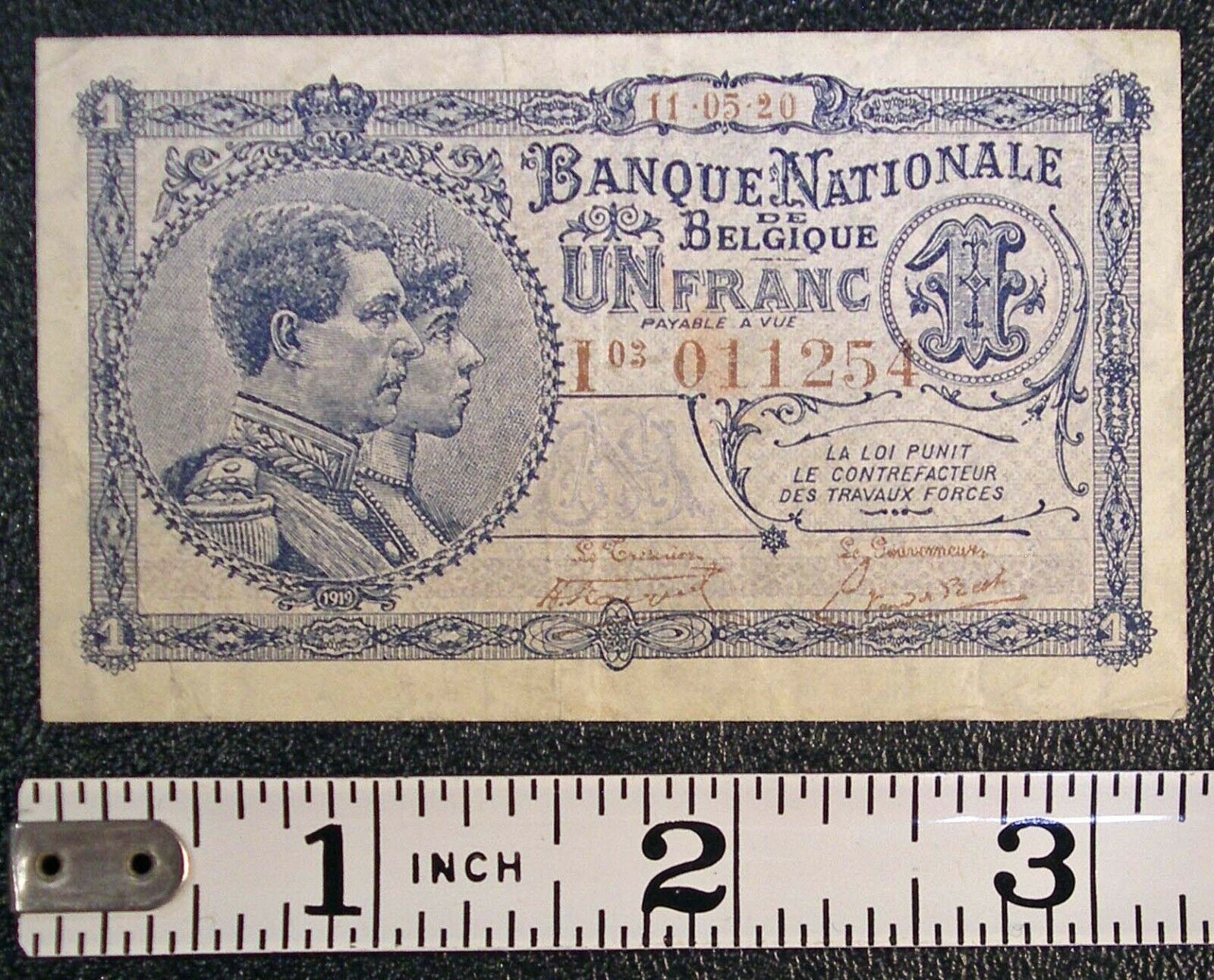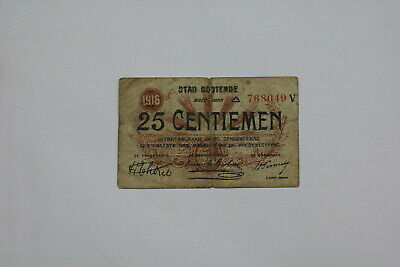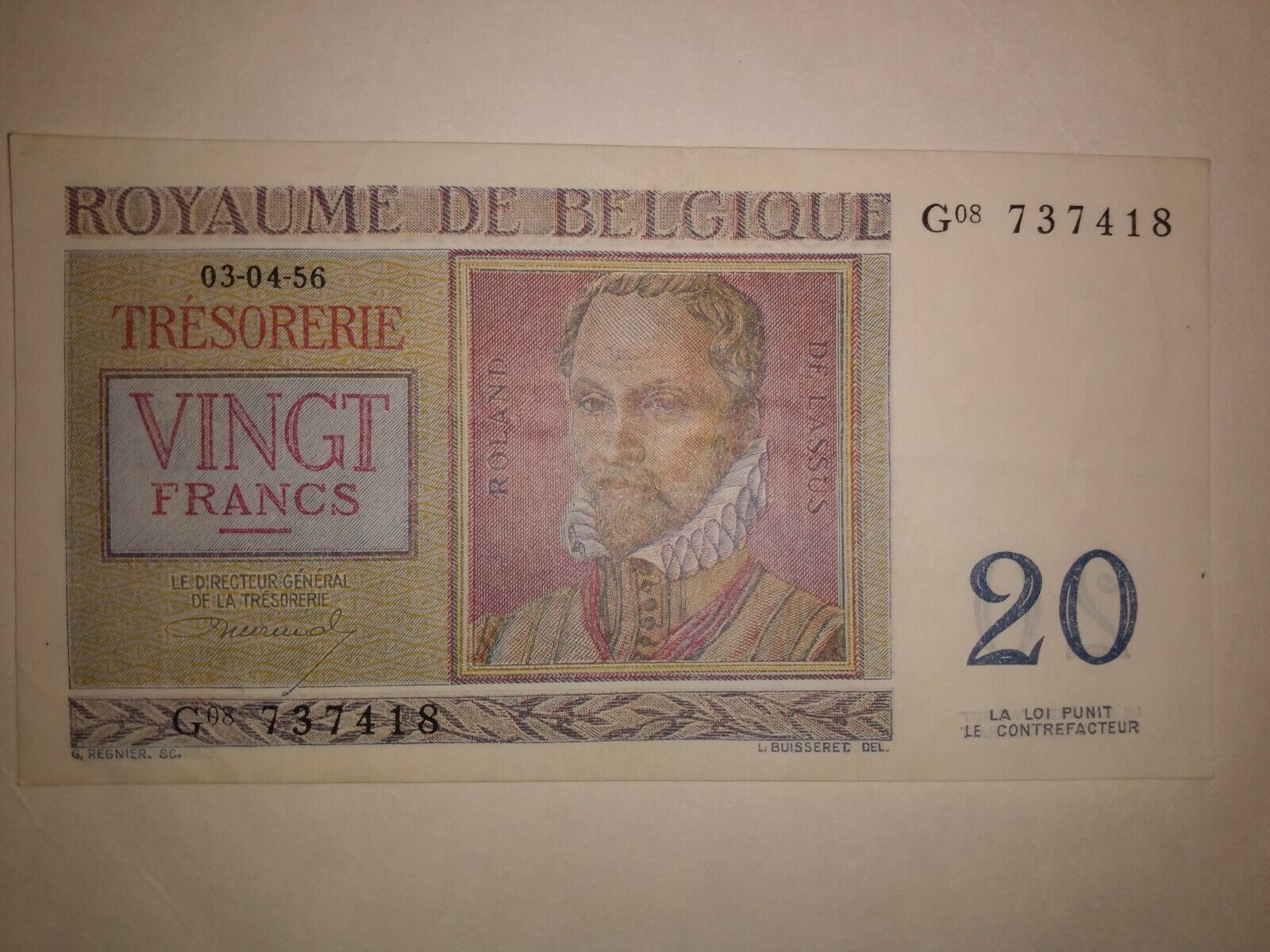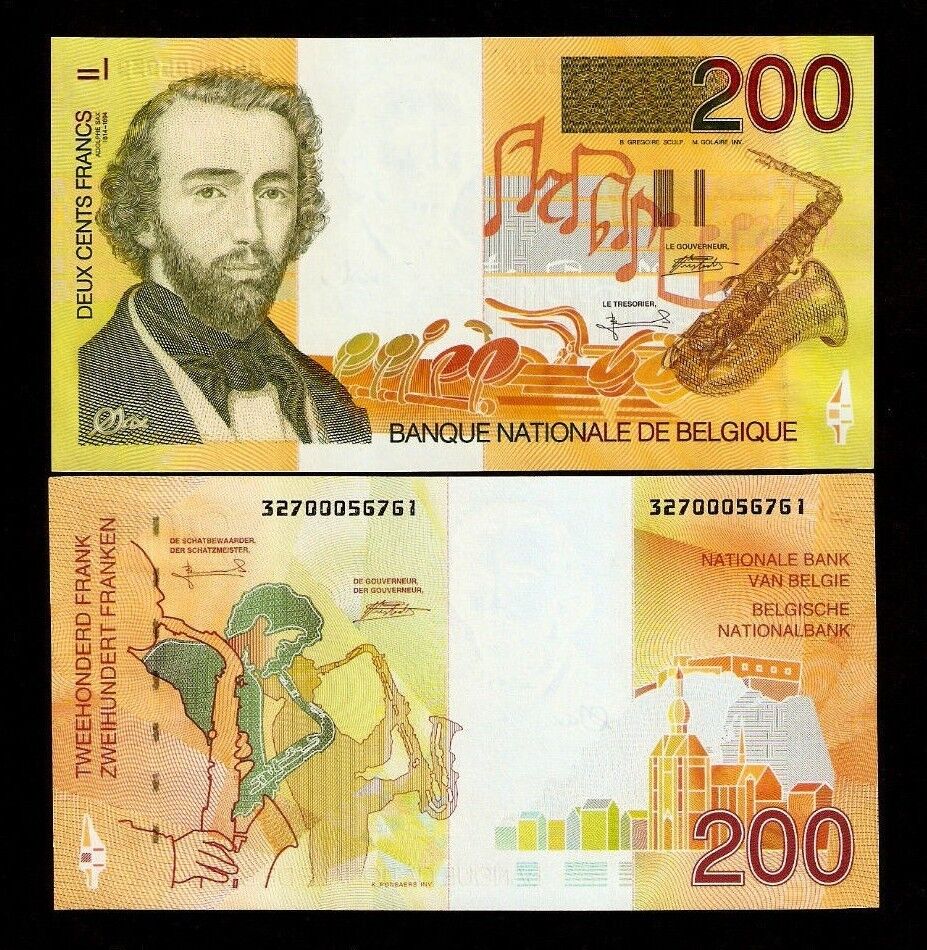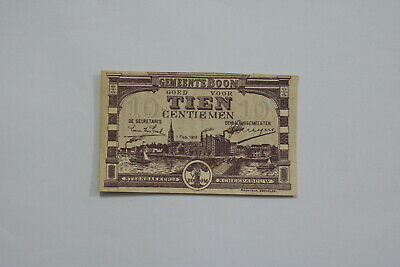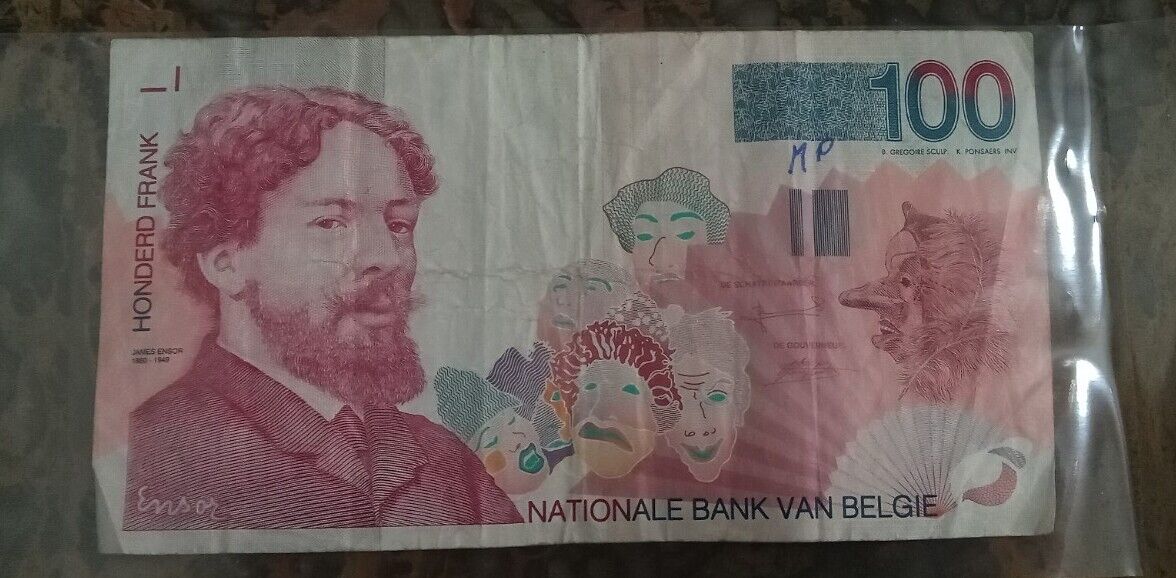-40%
Belgium banknote - 100 cent franc - year 1982 - Hendrik Beyaert - free shipping
$ 7.39
- Description
- Size Guide
Description
The Belgian franc (French: Franc belge, Dutch: Belgische frank, German: Belgischer Franken) was the currency of the Kingdom of Belgium from 1832 until 2002 when the Euro was introduced. It was subdivided into 100 subunits, known as centimes (French), centiem (Dutch) or Centime (German).The conquest of most of western Europe by revolutionary and Napoleonic France led to the French franc's wide circulation. In the Austrian Netherlands (the current Belgium), the franc replaced the kronenthaler. This was in turn replaced by the Dutch guilder when the United Kingdom of the Netherlands was formed.
Following independence from the Kingdom of the Netherlands, the new Kingdom of Belgium in 1832 adopted its own franc, equivalent to the French franc, followed by Luxembourg in 1848 and Switzerland in 1850.
Belgian mint working during the late 19th century was innovative and Belgium was the first country to introduce coins made of cupronickel, in 1860.
In 1865, Belgium, France, Switzerland and Italy created the Latin Monetary Union (to be joined by Greece in 1868): each would possess a national currency unit (franc, lira, drachma) worth 4.5 g of silver or 290.322 mg of fine gold, all freely exchangeable at a rate of 1:1. In the 1870s the gold value was made the fixed standard, a situation which was to continue until 1914.
In 1926, Belgium, as well as France, experienced depreciation and an abrupt collapse of confidence, leading to the introduction of a new gold currency for international transactions, the Belga worth 5 francs, and the country's withdrawal from the monetary union, which ceased to exist at the end of the year. The Belga was tied to the British pound at a rate of 35 belgas (175 francs) = 1 pound and was thus put on a gold standard of 1 Belga = 209.211 mg fine gold. The 1921 monetary union of Belgium and Luxembourg survived, however, forming the basis for full economic union in 1932. In 1935, the Belgian franc was devalued by 28% to 150.632 mg fine gold and the link between the Luxembourg and Belgian francs was revised to 1 Luxembourgish franc = 1 1⁄4 Belgian francs.
Following Belgium's occupation by Germany in May 1940, the franc was fixed at a value of 0.1 Reichsmark, reduced to 0.08 Reichsmark in July 1940. Following liberation in 1944, the franc entered into the Bretton Woods system, with an initial exchange rate of 43.77 francs = US dollar set on October 5. This was changed to 43.8275 in 1946 and then to 50 following the devaluation of the British pound in September 1949. The Belgian franc was devaluated again in 1982.
Like 10 other European currencies, the Belgian/Luxembourgish franc ceased to exist on January 1, 1999, when it became fixed at 1 EUR= 40.3399 BEF/LUF, thus a franc was worth € 0.024789. Old franc coins and notes lost their legal tender status on February 28, 2002.
Front: Effigy of architect Hendrik Beyaert (1823-1894) wearing spectacles (eyeglasses). Nationale Bank building as seen from Mechelsesteenweg (also located at Bourlastraat corner with Frankrijklei 164-166) in Antwerpen. National Bank's Hotel in Brussels. Wrought iron fencing. Back: Architectural decorative wrought iron fencing with arches. Three-dimensional geometric multi-faceted design. Watermark: Effigy of King Baudouin I in 1/2 profile. Work by: Yvon Adam; Manfred Hürrig; Anne Velghe (Inv. - Sketch authors, designers); C. Leclercqz (Sc. - Engraver). Colours: Maroon red, purple, green, blue, violet and salmon. Signatures: Pol Dasin (De Schatbewaarder - Le Tresorier); Jean Godeaux (De Gouverneur - Le Gouverneur). Year of issue: 1980. Printer: Unknown.
Hendrik Beyaert (Dutch) or Henri Beyaert (French) was a Belgian architect. He was born in Kortrijk, Belgium on 29 July 1823 and died in Brussels 22 January 1894. He is considered one of the most important Belgian architects of the 19th-century.
Hendrik Beyaert was of very humble descent. For this reason he had to earn his living from a very young age onwards. Initially he and his family couldn't afford to finance higher studies. At age 19, Hendrik Beyaert worked as a bank employee at the National Bank of Belgium's office in Kortrijk. He found his profession not very indulging and decided to quit the bank. As he had always been fascinated by architecture he found a post as an apprentice stonemason on the building site of the new railway station of Tournai, a building that would be replaced decades later by a design of Hendrik Beyeart himself.
In 1842 the young man went to Brussels where he kept a small bookshop to earn his living and where he enrolled at the Académie to attend the architecture courses. In the following year he met the architect Félix Janlet who believed in the young Beyaert's exceptional qualities and who offered him a job in his office. Due to this job and to a small scholarship granted to him by his native city Kortrijk, Beyaert could finish his architectures studies at the Académie Royale des Beaux-Arts which he completed in 1846. At the Académie he studied with Tilman-François Suys by whom he was largely influenced during the first years of his career as an independent architect. Beyaert gradually moved away from the neo-classical style if his master and began to experiment with a neo-Louis XVI style in the mansions he built along the Brussels Avenue des Arts and Chaussée de Charleroi.
His first public commission was the head-office of his former employer, the "Banque Nationale de Belgique". This cooperation with the architect Wynand Janssens resulted in a lavish neo-baroque building heavily influenced by the new style propagated in Paris, known as Second Empire. The critical success that it enjoyed, together with Beyaert’s connections with the powerful Liberal Party, led to many other commissions, beginning with the De Brouckère fountain (1866), now on the Square Jan Palfijn, Laeken. Other major works followed in rapid succession. In his major renovation projects of medieval buildings, such as the "Hallepoort" (or "Porte de Hal", a vestige of the medieval fortifications of Brussels) he was influenced by the French architect and theoretician Viollet-le-Duc. This realisation played an important role in Beyaert's architectural development for it made him aware of the importance and beauty of the local architectural styles from the late middle-ages and the early renaissance. Beyaert's style largely shifted to the so-called "Flemish Renaissance Revival" which partly under his influence would become a very popular "National" style in the last quarter of the 19th-century. Other works included the Antwerp Office of the National Bank of Belgium building (1874–79), built on a clever triangular plan, the Tournai Railway Station (1875–79, damaged in WWII), and the Kegeljan-Godin house (1878–1880) in Namur. All had a similar, vaguely Flemish Renaissance or Baroque Revival flavour. In 1876 however, Beyaert publicly denied being a partisan of the nascent Flemish Renaissance Revival movement in Belgium, although the proponents of this movement had wished to align his creations to their own.
With his passion for study and novelties - Beyaert possessed an extensive library on the history of architecture and the decorative arts - his buildings became more and more charged with historical ornamentation without however lacking a clear structural basis. In an architecture contest following the covering of the Zenne, Beyaert's "Maison des Chats/Kattenhuis" took first prize. It was built along the new central boulevard in Brussels and showed clear affinities with the famous Guild Houses at the nearby Brussels Grand Place. Beyaert also designed a number of country houses, including the "Romantic" Château de Faulx-les-Tombes near Namur (1872) which was highly influenced by Viollet-le-Duc's restoration of the Château de Pierrefonds, and the Neo Flemish Renaissance, Castle of Wespelaar (1881–87) in the province of Brabant. Although he had been interested in urban planning since the early 1860s, he could only realise one of his urban design projects: the Petit Sablon Square (1880) in Brussels. It consists of a small park on a trapezium-shaped site, surrounded by a wrought-iron fence of inventive design. His final realisation, crowning an impressive architectural career, is the Ministry of Railways, Post, Telegraph and Navy in Brussels. This project shows Beyaerts ability to cope with a rich ornamentation without attacking the structural integrity of the building. While certainly revivalist in character, his strongly geometric architecture imitated only the spirit and seldom the details of historical models. His own details were highly original. They were part of an architecture of space and structure rather than of mere decorative appearance. In this respect Beyaert would become instrumental in the formation of a new generation of architects, such as Paul Hankar and Victor Horta, that would play an important part in the evolution of Art Nouveau architecture.



